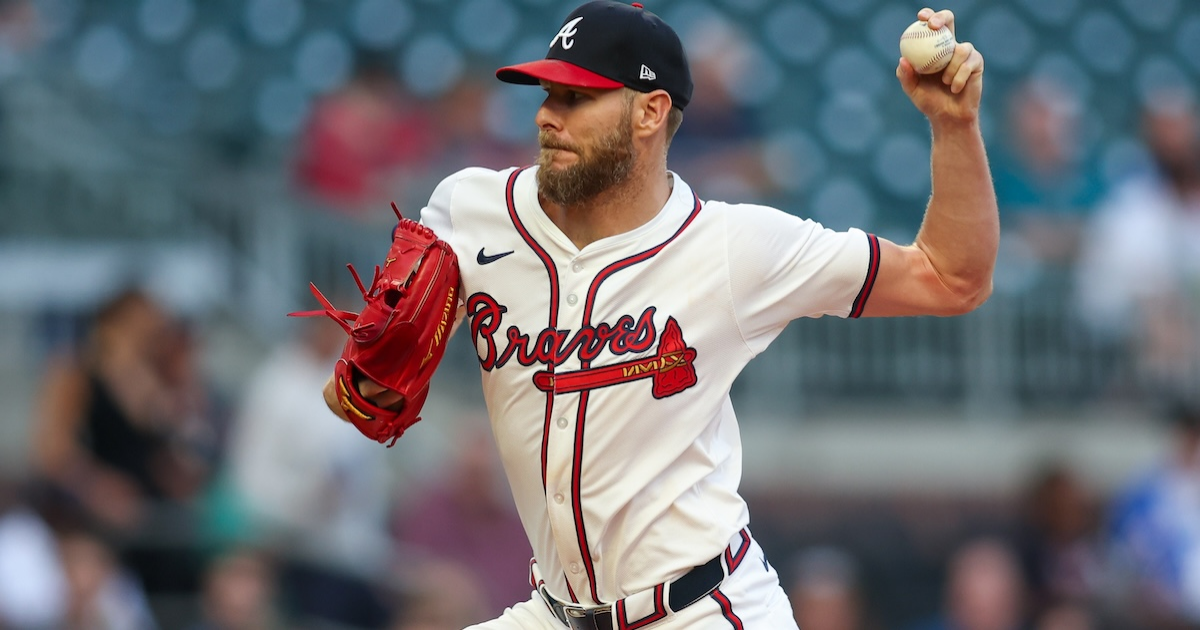 Brett Davis-Imagn Images
Brett Davis-Imagn Images
The Vernal equinox was last week, but we all know that today, Opening Day, marks the real end of winter. As I’ve done for the last two decades, I’ve had ZiPS crunch the numbers and generate projected standings for the upcoming season. Now, we just wait for reality to destroy all those neat little projections. But first, a quick reminder of methodology.
The big change here is that ZiPS now does include spring training performance. The data is weighted significantly less than regular season performance, but one should treat projections as a constantly moving thing, not one static unchanging number. Every baseball thing has some potential to change a player’s outlook; just because data is harder to use doesn’t mean it’s meaningless. So check out some projections such as Jac Caglianone, Cam Smith, and Spencer Schwellenbach to see some of the players who got significant spring boosts.
These standings are the result of a million simulations, not results obtained from binomial or even beta-binomial magic. The methodology isn’t identical to the one we use for our playoff odds. So how does ZiPS calculate the season? Stored within ZiPS are the first- through 99th-percentile projections for each player. I start by making a generalized depth chart, using our Depth Charts as a jumping off point. Since these are my curated projections, I make changes based on arbitrary whimsy my logic and reasoning. ZiPS then generates a million versions of each team in Monte Carlo fashion.
After that is done, ZiPS applies another set of algorithms with a generalized distribution of injury risk that changes the baseline plate appearances or innings pitched for each player. ZiPS then automatically and proportionally “fills in” playing time from the next players on the list to get to a full slate of plate appearances and innings.
The result is a million different rosters for each team and an associated winning percentage for each million of them. After applying the new strength of schedule calculations based on the other 29 teams, I end up with the standings for each of the million seasons. I promise this is much less complex than it sounds.
The goal of ZiPS is to be less awful than any other way of predicting the future. The future is tantalizingly close but beyond our knowledge, and if anyone figures out how to deflect the astrophysicist Arthur Eddington’s arrow of time, it’s probably not going to be in the form of baseball projections. So we project probabilities, not certainties. If this does not satisfy you, just assume that any deviation from the actual results are due to flaws in reality.
Over the last decade, ZiPS has averaged 19.2 correct teams when looking at Vegas preseason over/under lines. I’m always tinkering with methodology, but most of the low-hanging fruit in predicting how teams will perform has already been harvested. ZiPS’ misses for teams from year to year are uncorrelated, with an r-squared of one year’s miss to the next of 0.000541. In other words, none of the year-to-year misses for individual franchises has told us anything about future misses for those franchises.
Also, ZiPS has no information on the first two games of the season, played by the Dodgers and Cubs, so technically, the Dodgers should be up 0.8 wins and the Cubs down 0.8 wins. But cheating is not allowed! I’ve included a couple notes in with the standings; despite doing player projection updates, a relatively quiet spring from a signing/trade/injury standpoint has left this season as having the smallest movement from the start of spring training to Opening Day in the years I’ve been doing this.
ZiPS Projected Standings – AL East
Team W L GB Pct Div% WC% Playoff% WS Win% 80th 20th Baltimore Orioles 88 74 — .543 29.8% 33.6% 63.4% 6.0% 95.5 81.0 Boston Red Sox 87 75 1 .537 24.4% 33.8% 58.2% 3.9% 94.2 79.9 New York Yankees 87 75 1 .537 24.1% 32.6% 56.7% 5.2% 94.3 79.4 Toronto Blue Jays 83 79 5 .512 13.2% 27.1% 40.3% 2.3% 90.7 75.5 Tampa Bay Rays 82 80 6 .506 8.6% 21.8% 30.4% 1.4% 88.3 73.9
There weren’t a lot of major changes this spring, but the Yankees are one of them, because of the injury to Gerrit Cole. ZiPS thinks they’ll get better-than-replacement performance from the pitchers covering his lost innings, but not having one of the best pitchers in baseball for the entire season does knock the Yankees down a bit in the standings. The O’s also dropped in the projections; some of that is due to changed projections generally, some due to fewer innings projected from Grayson Rodriguez.
The Red Sox saw the biggest improvement in the East, thanks primarily to the Alex Bregman signing, which happened after I ran the start-of-spring projections, and a further positive bump to Garrett Crochet’s projection. They also got a slight boost from more playing time projected for Kristian Campbell and Marcelo Mayer.
Toronto did well, too, with the gainers in these projections comfortably outnumbering the decliners.
ZiPS Projected Standings – AL Central
Team W L GB Pct Div% WC% Playoff% WS Win% 80th 20th Cleveland Guardians 85 77 — .525 32.4% 19.1% 51.5% 3.7% 92.1 77.9 Minnesota Twins 84 78 1 .519 28.9% 18.6% 47.6% 3.2% 91.4 77.0 Kansas City Royals 83 79 2 .512 22.7% 17.6% 40.4% 2.2% 90.0 75.4 Detroit Tigers 81 81 4 .500 16.0% 14.8% 30.7% 1.3% 87.9 73.3 Chicago White Sox 52 110 33 .321 0.0% 0.0% 0.0% 0.0% 59.1 45.0
ZiPS is happy with the Tyler Freeman–Nolan Jones trade — at least as far as the Guardians are concerned. And while there’s not a huge gulf in their bottom-line projections, ZiPS sees Jones as having the more interesting upside and fulfilling a more crucial team need than Freeman.
Carlos Correa had a brutal spring, but his wRC+ projection only dropped three points as a result, and the Twins projections are mostly about the same as they were at the start of spring. The only player to move by five points or more of wRC+ or ERA+ was Zebby Matthews, who earned a spot on my breakouts list.
Jac Caglianone of the Royals was the biggest mover in the spring, either positive or negative, but he’s not projected to get enough playing time to really change Kansas City’s bottom line. I would have liked to see the Royals make more of an effort to find an outfielder in the spring, but I didn’t really expect that to happen.
The Tigers acquired veteran Manuel Margot over the weekend, but because the signing was the consequence of bad injury news for Detroit’s outfield, his addition didn’t push the team’s projection in a positive direction. It’s also possible I was too conservative at projecting when Parker Meadows will return from his 60-day IL stint, but we’ll have to wait a few months on that.
Somehow, the White Sox actually got slightly worse since the last projection run.
ZiPS Projected Standings – AL West
Team W L GB Pct Div% WC% Playoff% WS Win% 80th 20th Houston Astros 90 72 — .556 50.6% 22.2% 72.8% 8.8% 97.7 82.6 Seattle Mariners 85 77 5 .525 24.1% 26.5% 50.6% 3.8% 92.3 78.1 Texas Rangers 85 77 5 .525 23.2% 25.7% 48.9% 3.5% 92.3 77.4 Athletics 71 91 19 .438 1.4% 4.2% 5.6% 0.1% 78.9 63.9 Los Angeles Angels 70 92 20 .432 0.8% 2.4% 3.1% 0.0% 76.8 62.1
Cam Smith was a big mover this spring, but ZiPS wasn’t high on him to begin with, and his improvement wasn’t enough for him to be of much consequence to Houston’s projection in the AL West. However, the Astros have seen their chances of being the American League’s winningest team go up a bit, from 30% to 32%, thanks to misfortune for the Yankees and Orioles.
The rest of the AL West looks very similar to how it did at the start of spring training. Let’s put it this way: The best player to sign with a team in the division over the last month was Patrick Corbin. These projections do include the Ian Anderson–José Suarez trade, but the projections basically consider that a wash.
ZiPS Projected Standings – NL East
Team W L GB Pct Div% WC% Playoff% WS Win% 80th 20th Atlanta Braves 89 73 — .549 35.8% 34.0% 69.8% 7.3% 96.4 81.6 Philadelphia Phillies 89 73 — .549 34.0% 34.6% 68.6% 6.6% 96.0 81.5 New York Mets 88 74 1 .543 29.5% 35.3% 64.8% 5.6% 95.0 80.7 Washington Nationals 69 93 20 .426 0.5% 3.0% 3.4% 0.0% 76.6 62.3 Miami Marlins 67 95 22 .414 0.2% 1.3% 1.6% 0.0% 73.8 59.0
The pattern of very close races continues with the NL East, and whether the Braves, Phillies, or Mets is the ZiPS plurality favorite can shift just by changing a couple assumptions slightly. Naturally, this means that the NL East champion will win the division by 20 games.
I continue to find the Nationals far more interesting than the projections do. Their offensive core is developing nicely, but ZiPS absolutely abhors their pitching. I think the NL East has too many good teams for the Nats to make a surprise division run, but if the rotation is shockingly adequate, I think the roster has a lot of “reach” to push for a Wild Card berth, and as a result, I like the Nats more than any other team projected for fewer than 75 wins.
I do not have a similar optimism about the Marlins. If the Nats surprise, they’ll contend. If the Marlins surprise, they’ll probably just trade their best players in July. For example, if Sandy Alcantara bounces back into Cy Young form, I fully expect him to be a Yankee or a Dodger by the beginning of August.
ZiPS Projected Standings – NL Central
Team W L GB Pct Div% WC% Playoff% WS Win% 80th 20th Chicago Cubs 86 76 — .531 37.3% 18.7% 56.0% 4.1% 92.8 78.4 Milwaukee Brewers 84 78 2 .519 31.6% 19.0% 50.5% 3.3% 91.8 77.0 St. Louis Cardinals 79 83 7 .488 12.1% 13.2% 25.3% 0.9% 86.1 71.4 Cincinnati Reds 79 83 7 .488 10.0% 11.6% 21.6% 0.7% 85.1 70.0 Pittsburgh Pirates 77 85 9 .475 9.0% 10.7% 19.7% 0.6% 84.5 69.7
Cam Smith’s quick emergence with the Astros might sting a tad for Cubs fans, knowing that he could’ve broken out in Chicago, but I don’t think anyone will look back on the trade that sent him to Houston with regret considering the return was Kyle Tucker — especially not if the Cubs win the division. I still have a gut feeling that they are one of the teams most likely to pull an early-season trade for a pitcher, given how strong their offense is compared to their rotation and bullpen, but that’s beyond the purview of these projections.
The Brewers actually had several movers in the projections, with Oliver Dunn and Vinny Capra looking quite a bit more playable after excellent springs, though not enough to dramatically change the team’s no. 27 Depth Charts ranking at third base. ZiPS is now more optimistic about Rhys Hoskins than any other projection system.
The Cardinals, Reds, and Pirates still look like a significant step down from the Brewers and Cubs, but even the worst projected team, the Pirates, has nearly a one-in-five chance to make the playoffs and just short of a one-in-10 shot to win the division.
ZiPS Projected Standings – NL West
Team W L GB Pct Div% WC% Playoff% WS Win% 80th 20th Los Angeles Dodgers 98 64 — .605 73.1% 20.6% 93.7% 18.7% 107.8 92.3 Arizona Diamondbacks 86 76 12 .531 12.3% 41.8% 54.1% 3.3% 92.8 78.4 San Diego Padres 85 77 13 .525 12.4% 39.6% 51.9% 3.3% 92.9 76.8 San Francisco Giants 78 84 20 .481 2.3% 16.4% 18.7% 0.5% 84.7 69.8 Colorado Rockies 63 99 35 .389 0.0% 0.3% 0.3% 0.0% 69.8 55.4
Only a single Los Angeles hitter lost more than two points of wRC+ (Andy Pages), and the Dodgers avoided any new Tommy John surgery appointments, so they crept up a little more in the division. Their 20th-percentile projection is now up to 108 wins.
The Diamondbacks look strong, but the Jordan Montgomery injury might matter if they need pitching depth.
The Giants went 21-6 in the Cactus League, but though their projection improved a bit, they still project to finish with a losing record. San Francisco’s pitching saw more improvements than its hitting, with Camilo Doval, Hayden Birdsong, Robbie Ray, and Logan Webb all getting bumps.
As usual, I’m including the ZiPS playoff chart, which shows what the chances are that a number of wins is achieved by the division and Wild Card winners. For example, ZiPS projects the team that wins the AL West to have, on average, 94.4 wins, but 20% of the projected AL West winners finish with only an 89-73 record.
ZiPS Playoff Matrix
To Win 10th 20th 30th 40th 50th 60th 70th 80th 90th AL East 89.0 91.3 93.0 94.6 96.0 97.5 99.1 101.0 103.6 AL Central 84.3 86.8 88.5 90.1 91.5 93.0 94.6 96.4 99.1 AL West 86.3 89.0 90.9 92.6 94.2 95.8 97.6 99.7 102.6 AL Wild Card 1 87.4 89.0 90.2 91.3 92.3 93.3 94.4 95.8 97.8 AL Wild Card 2 84.6 86.0 87.1 88.0 88.8 89.7 90.7 91.9 93.5 AL Wild Card 3 82.4 83.8 84.8 85.6 86.4 87.3 88.1 89.2 90.6 NL East 87.9 90.5 92.4 94.1 95.6 97.2 98.9 100.9 103.7 NL Central 84.4 86.7 88.5 90.1 91.6 93.1 94.7 96.7 99.4 NL West 89.9 92.6 94.6 96.4 98.2 100.7 104.6 107.6 109.1 NL Wild Card 1 87.3 89.1 90.3 91.4 92.5 93.6 94.8 96.2 98.3 NL Wild Card 2 84.1 85.7 86.8 87.7 88.7 89.6 90.6 91.8 93.4 NL Wild Card 3 81.6 83.1 84.2 85.1 85.9 86.8 87.7 88.8 90.3



